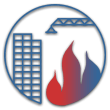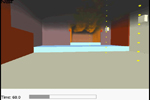|
|
|
|
|
|
|
|
|
|
|
|
 |
 |
 |
 |
|||||||
|
|
||||||||||
 |
 |
 |
 |
 |
 |
 |
 |
|||
Building and Fire Safety Investigations
More information and links to reports:
World Trade Center Investigation National Construction Safety Team (NCST) Investigations Other Building and Fire Safety Investigations Overview
Buildings, bridges, and other man-made structures are not supposed to fall down. But sometimes they do, and for different reasons: fire, earthquakes, high winds, errors in design and construction, flaws in materials, and even terrorist attacks. Under the National Construction Safety Team (NCST) Act, signed into law in October 2002, the National Institute of Standards and Technology (NIST) is authorized to investigate major building failures in the United States. The NIST investigations will establish the likely technical causes of the building failure and evaluate the technical aspects of emergency response and evacuation procedures in the wake of such failures. The goal is to recommend improvements to the way in which buildings are designed, constructed, maintained, and used.
Independent Investigator
NIST has more than 30 years of experience investigating building fire and structural failures. Since NIST is not a regulatory agency and does not issue building standards or codes, the institute is viewed as a neutral, “third party” investigator. According to the NCST Act, no part of any report resulting from investigations can be admitted as evidence or used in any suit or action for damages. Additionally, NIST employees are not permitted to serve as expert witnesses.
Other federal agencies and state and local governments, as well as private-sector and non-profit organizations, may request assistance in conducting post-disaster fires and failure investigations. NIST also is authorized to conduct basic and applied fire research, including fire investigations, for the purposes of understanding fundamental fire behavior and to reduce losses from fire.
Scientists and engineers in the NIST Building and Fire Research Laboratory (BFRL)—who develop the tools and technology to improve the performance of structures—often lead a failure investigation. BFRL expertise covers such areas of concern as concrete and steel construction, earthquake engineering, construction automation, and fire performance in structural systems. Other NIST experts, such as materials scientists, manufacturing engineers, and electronic engineers, often provide their specialized knowledge to investigations.
Field and Lab Tests
Typically, NIST researchers conduct an extensive field investigation at the disaster site to determine conditions before and after the structural failure. Documents such as drawings, specifications, and inspection reports, as well as eyewitness accounts and videos, are reviewed to gain information about the design and construction of the structure, and the events of the actual failure incident. When necessary, laboratory tests are conducted to determine physical properties of failed materials. NIST may fabricate mockups or replicas of structure parts and test these. In addition to laboratory tests, analytical models and computer simulations may help determine likely causes of failure.
The NIST laboratories are well-equipped to conduct investigations. For example, NIST has several types of universal testing machines that can apply tension and compression forces on structural components up to 18 meters (60 feet) tall. Other labs include a tri-directional test facility for testing structural components and connections under the types of loads occurring during an earthquake, and a large fire laboratory with the capability of conducting well-controlled experiments in fires releasing heat up to 10 megawatts (typical of a multiroom fire).
Investigation Benefits
By understanding the technical causes leading to structural failures and then making that information public, NIST engineers and researchers strive to prevent similar failures in the future. Examples of benefits from past NIST investigations include:
- A simulation/re-creation of a 1999 multiple fatality fire in a Washington, D.C., townhome utilized NIST’s Fire Dynamic Simulator (FDS) computer fire modeling software.
- The use of FDS significantly advanced the understanding of the incident that caused the death of two firefighters and led to procedural changes designed to save the lives of emergency responders.
- Improvements in the Occupational Safety and Health Administration’s safety and inspection requirements for lift-slab construction operations as a result of concerns raised by NIST’s assessment of the 1987 collapse of the under-construction L’Ambiance Plaza apartment building in Bridgeport, Conn.
- The adoption of a document, for the first time, by the American Society of Civil Engineers that assigned responsibility for various aspects of the construction process as a result of analyzing the 1981 collapse of walkways in the Kansas City (Mo.)
- Hyatt Regency Hotel. Safer bridges nationwide resulting from the study of the 1967 collapse of the Point Pleasant Bridge linking West Virginia and Ohio.
- A new carbon steel that tended to crack in areas of heavy corrosion was identified as the culprit, prompting federal highway officials to look for similar cracks in all U.S. highway bridges and have them repaired.
Impact on Codes, Standards, and Practices
By understanding the technical causes leading to structural failures and then making that information public, NIST engineers and researchers strive to prevent similar failures in the future. Investigations conducted by NIST have led to significant changes in practices, standards, and codes to enhance the health and safety of the American public. Examples include:
- A simulation/re-creation of a 1999 multiple fatality fire in a Washington, D.C., town home utilized NIST’s Fire Dynamic Simulator (FDS) computer fire modeling software. The use of FDS significantly advanced the understanding of the incident that caused the death of two firefighters and led to procedural changes designed to save the lives of emergency responders.
- An investigation following the Jarrell, TX, tornado of 1997, and subsequent research at the Texas Tech University with NIST funding and guidance, led to the development of an enhanced Fujita (EF) scale for tornado intensity (used to estimate wind speed based on observed damage to physical structures) by the Working Group for Natural Disaster Reduction/Post-Storm Data Acquisition in the Office of the Federal Coordinator for Meteorology (which includes NIST as a member). NOAA's National Weather Service has announced that it is changing the Fujita tornado intensity scale, a 3-decade old system for ranking a tornado's strength, effective February 2007. The new scale will be implemented by the National Weather Service on a trial basis during the Spring 2006 severe weather season.
- Improvements in the American Institute of Steel Construction design practices for welded steel framed structures that developed unanticipated cracks at their beam-to-column connections during the Northridge, California, earthquake in 1994.
- Improvements to the wind speed requirements for coastal and near coastal regions and anchoring provisions for manufactured (mobile) homes in the Department of Housing and Urban Development national regulatory standards following Hurricane Andrew which struck Florida in 1992 and Hurricane Camille which struck Mississippi in 1969.
- Improvements in the Occupational Safety and Health Administration’s safety and inspection requirements for lift-slab construction operations as a result of concerns raised by NIST’s assessment of the 1987 collapse of the under-construction L’Ambiance Plaza apartment building in Bridgeport, Conn.
- The adoption of a document, for the first time, by the American Society of Civil Engineers that assigned responsibility for various aspects of the construction process as a result of analyzing the 1981 collapse of walkways in the Kansas City (Mo.) Hyatt Regency Hotel.
- Safer bridges nationwide resulting from the study of the 1967 collapse of the Point Pleasant Bridge linking West Virginia and Ohio. A new carbon steel that tended to crack in areas of heavy corrosion was identified as the culprit, prompting federal highway officials to look for similar cracks in all U.S. highway bridges and have them repaired.
Investigations
To date, two investigations have come under the authority of the National Construction Safety Team Act (NCST). Since August 2002, NIST is conducting a $16 million federal building and fire safety investigation to study the structural failure and subsequent progressive collapse of several World Trade Center (WTC) buildings following the terrorist attacks of Sept. 11, 2001, in New York City. The study of WTC Buildings 1 and 2 (the “Twin Towers”) and WTC Building 7 focuses on the building construction, the materials used, and the technical conditions that contributed to the outcome of the disaster.
Between February 2003 and March 2005, NIST led a team of public and private-sector fire and safety experts in an investigation of the Feb. 20, 2003, fire at The Station nightclub in West Warwick, R.I. The team’s primary objectives were to: determine the conditions in the nightclub prior to the fire; reconstruct the fire ignition, fire spread, and survivability within the building using computer models; examine the impact on survivability of having an installed sprinkler system, all other conditions being the same; and analyze the emergency evacuation and occupant responses to better understand impediments to safe egress.
Other building fire and structural failure investigations in which NIST has participated or led include:
- Fire and building collapse, Charleston, S.C., 2007
- Elks Lodge building collapse reconnaissance, Clinton, Missouri, 2006
- Hurricane Katrina and Hurricane Rita reconnaissance, 2005
- Cook County Administration Building Fire, Chicago, IL, 2003
- Terrorist attack, Pentagon, Washington, D.C., 2001
- Cherry Road fire reconstruction, Washington, D.C., 1999
- Two-story duplex fire, Iowa, 1999
- Apartment fire, New York City, 1998
- Terrorist bombing, Murrah Federal Building, Oklahoma City, Okla., 1995
- Building fire, Happyland Social Club, Bronx, N.Y., 1990
- Tank failure, Ashland Oil Co., Pittsburgh, Pa., 1988
- Building fire, First Interstate Bank Building, Los Angeles, Calif., 1988
- Building fire, Dupont Plaza Hotel, San Juan, Puerto Rico, 1986
- Walkway collapse, Kansas City, MO, 1981
- Highway ramp failure, East Chicago, Ind., 1982
- Condominium collapse, Cocoa Beach, Fla., 1981
- Cooling tower collapse, Willow Island, W.Va., 1978
- Apartment building collapse, Bailey’s Crossroads, Va., 1973
In addition, NIST conducts damage assessments following natural disasters. Past examples include:
- Earthquake, Kocaeli, Turkey, 1999
- Tornado, Oklahoma City, Okla., 1998
- Hurricanes Mitch (Central America) and Georges (Caribbean), 1998
- Hurricane Fran, North Carolina, 1998
- Tornado, Jarrell, TX, 1997
- Earthquake, Kobe, Japan, 1995
- Hurricane Marilyn, U.S. Virgin Islands, 1995
- Earthquake, Northridge, Calif., 1994
- Hurricane Andrew, Florida, 1992
- Loma Prieta Earthquake, Santa Cruz, Calif., 1989
- Earthquake, Armenia, 1988
- Earthquake, Mexico City, Mexico, 1985
For inquires regarding NIST building and fire research investigations, contact investigations@nist.gov.
|
Privacy Policy / Security Notice / Accessibility | Disclaimer | FOIA NIST is an agency of the U.S. Department of Commerce |

|
Last updated: 2/14/2008


